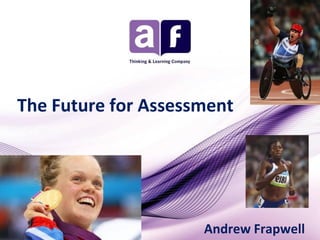The Future of Assessment in Physical Education
- 1. The Future for Assessment Andrew Frapwell
- 2. The future?
- 4. Session aims: ŌĆó accurately contrast Assessment for Learning and Assessment of Learning ŌĆó consider the purpose of assessment and the match to practice ŌĆó explore connections between values for assessment and assessment for change
- 5. Personalisation What are your expectations?
- 6. Accurately contrast Assessment for Learning and Assessment of Learning ASSESSMENT FOR LEARNING & ASSESSMENT OF LEARNING
- 7. Assessment of Learning / Assessment for Learning ŌĆó Assessment of Learning how much pupils have learnt at a particular moment in time the end of a unit / end of a year / end of a key stage ŌĆó Assessment for Learning ŌĆō how can we use assessment to help pupils learn more and progress quicker?
- 8. Compare and Contrast Informal Assessment Formal Assessment Flexible Dynamic Individualized Continuous Process-Based Progress Measuring Structured Static Standardized Episodic Product-Based Knowledge Testing
- 9. Assessment of Learning / Assessment for Learning ŌĆó Effect of previous practices ŌĆō pupils levelled for each activity, sub-levelled and ŌĆśdatarisedŌĆÖ ŌĆó ŌĆśNewŌĆÖ expectation ŌĆō assure competence, competition, activity, healthy active lifestyles ŌĆó Implication ŌĆō information gleaned from assessment should help all learners succeed
- 10. Starting point: AfL defined as ŌĆśa process of seeking and interpreting evidence for use by learners and their teachers to decide where the learners are in their learning, where they need to go, and how best to get there.ŌĆÖ (ARG, 2001) Four types of action: 1. eliciting information through questioning and dialogue 2. providing feedback with emphasis on how to improve 3. helping learners understand quality criteria 4. peer- and self-assessment (which incorporates 1-3)
- 11. Zeitgeist? ŌĆó We donŌĆÖt need to understand sound assessment procedures ŌĆō the national tests and FFT will take care of us ŌĆó Re-emphasize the learning function of assessment ŌĆō de-emphasise the grading function
- 12. Assessment th (14 June) ŌĆó Removal of ŌĆślevelsŌĆÖ ŌĆó Prescription does not fit with freedoms ŌĆó Introduce own approaches to formative assessment ŌĆó Report as to whether on track to meet expectations at the end of a key stage ŌĆó Curriculum and assessment systems must meet the needs of your pupils ŌĆó Work with Subject Associations (and others) to produce a range of approaches
- 13. Consider the purpose of assessments and the match to practice THE PURPOSE OF ASSESSMENT
- 14. Assessment ŌĆō fit for purpose ŌĆó We need to address whether the purpose of assessment matches the purpose of physical education
- 15. The Purpose of Assessment ŌĆó Hitting the target ŌĆō missing the point ŌĆó 999 Ambulance response time versus levels of progress
- 16. Fit for Purpose: Every child knows how they are doing, understands what they need to do to improve and how to get there; Every teacher is equipped to make well-founded judgements, understands the concepts and principles of progression, and knows how to use their assessment judgements to forward plan; Assessment systems should be structured and systematic for making regular, useful, manageable and accurate assessments of pupils, and for tracking their progress; Every parent and carer knows how their child is doing, what they need to do to improve, and how they can support the child and their teachers 16
- 17. Levelling activities versus: developing a subject profile of achievement
- 18. Full picture?




















